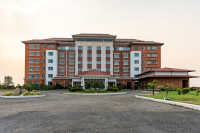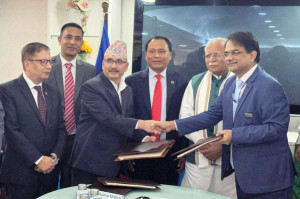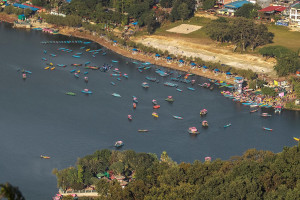Money
China deal offers Nepal more options for third country trade
With Beijing officially allowing Nepal to use a number of its land and sea ports, Nepali traders can now use the transit facility via three countries—India, Bangladesh and China.
Rajesh Khanal
With Beijing officially allowing Nepal to use a number of its land and sea ports, Nepali traders can now use the transit facility via three countries—India, Bangladesh and China.
During President Bidya Devi Bhandari’s state visit to China last week, Nepal and China signed the Protocol on Implementing Agreement on Transit and Transport along with six other deals in Beijing. The agreement has added up one more transit route for Nepal for carrying out trade with third countries.
With the three gateways for third country trade in place, Nepal can use a transit route based on the comparative advantage, said the Ministry of Commerce and Industry. Speaking at a programme on Tuesday, Secretary of the ministry Kedar Bahadur Adhikari said the government would facilitate the use of the transit routes based on the time and cost incurred for shipments of traded goods.
As of now, Nepal has been using two sea ports of India—Kolkata/Haldiya and Vishakhapatnam—for trade with third countries.
Similarly, Nepal has also signed an agreement with Bangladesh to use six ports, out of which Nepal has been using the only dry port of Banglabandha till the date.
Secretary Adhikari said the government had sent a letter of exchange to Bangladesh to allow Nepal to use additional sea ports.
The latest deal with China allows Nepal to use the Chinese sea ports in Tianjin, Shenzhen, Lianyungang and Zhanjiang and land ports in Lanzhou, Lhasa and Shigatse—for third-country trade. It will also allow Nepal to carry out exports and imports through six dedicated transit points along the Nepal-China border: Rasuwagadhi, Kodari, Yari, Kimathanka, Olangchungola and Nechung. Of these, only Rasuwagadhi is in operation at present.
The government has planned to bring transit points at Kodari and Yari into operation soon, Adhikari said. “As for the three remaining border points, the government has decided to speed up the construction of infrastructure to avail the privilege,” he said.
While the Chinese side has already built necessary infrastructure to operate these border points, a lot of works remain to be done on the Nepali side.
Giving an example of the Rasuwa-Syaphrubesi road segment-which is at the final stage of its completion, Adhikari said the government has also awarded the contract to build a dry port in Timure of Rasuwagadhi.
According to the ministry, the protocol allows Nepal to use all three kinds of services-inland, road and rail-at these six borders. “Besides, Beijing has also agreed not to allot a designated route to the Nepali side while trading through China,” said Adhikari, adding that Nepal could use any cost effective routes in China for the purpose. The two countries have also agreed to form a secretary-level intergovernmental committee and a joint-secretary level Joint Consultative Sub-committee for resolving bilateral issues related to trade and transit.
Adhikari said the ministry has formed two technical committees to conduct a field-based study on operation of the transit facility put forth by China. “In addition, the ministry has targeted to implement working guidelines by next month to facilitate the traders in using the Chinese transit routes soon,” he said.




 23.12°C Kathmandu
23.12°C Kathmandu















